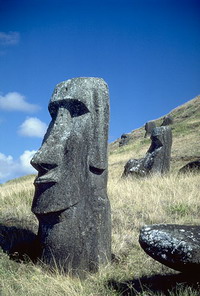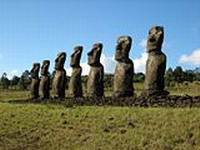Login form
The MOAI in Easter island
 When we think of Eastern Island we think of of huge stone carved figures - monoliths- that dot the coastline. They are called Moai - (pronounced moe-eye). Moai are statues carved of compressed volcanic ash on Rapa Nui (Easter Island). The statues are all monolithic, that is, carved in one piece. However, less than about one-fifth of the statues that were moved to ceremonial sites and then erected once had red stone cylinders pukau placed on their heads. These "topknots," as they are often called, were carved in a single quarry known as Puna Pau. About 95% of the 887 moai known to date were carved out of compressed volcanic ash at Rano Raraku, where 394 moai still remain visible today. Recent GPS mapping in the interior will certainly add additional moai to that count. The quarries in Rano Raraku appear to have been abandoned abruptly, with many incomplete statues still in situ.
When we think of Eastern Island we think of of huge stone carved figures - monoliths- that dot the coastline. They are called Moai - (pronounced moe-eye). Moai are statues carved of compressed volcanic ash on Rapa Nui (Easter Island). The statues are all monolithic, that is, carved in one piece. However, less than about one-fifth of the statues that were moved to ceremonial sites and then erected once had red stone cylinders pukau placed on their heads. These "topknots," as they are often called, were carved in a single quarry known as Puna Pau. About 95% of the 887 moai known to date were carved out of compressed volcanic ash at Rano Raraku, where 394 moai still remain visible today. Recent GPS mapping in the interior will certainly add additional moai to that count. The quarries in Rano Raraku appear to have been abandoned abruptly, with many incomplete statues still in situ.
The giant stone sculptures commonly weigh between 10 and 12 metric tons. Their average height is roughly 13 feet, but they range anywhere from 8 feet to an unfinished example over 70 feet high. Moai are characterized by long sloping noses, strong brows, deeply inset eyes, and prominent chins. Some examples also wear a hatlike cylinder made of red stone on their heads, which may represent a headdress or elaborate hairstyle. Each moai was commissioned by a specific individual or group and created by a team of expert stoneworkers under the direction of a master carver. As many as fifteen people began by quarrying a large rectangular block using basalt picks (toki). Once the figure was roughed out, the master carver and his assistants added the fine details, usually beginning with the head and face. Afterwards, a team of workers used ropes and levers to move the sculpture down the quarry slope. It was then set upright and the remainder of the carving was completed. The finished sculpture was then moved to its final destination using a wooden sled or rollers. Experimental re-creation of this feat by modern archaeologists suggests that it required approximately 40 individuals to move an average-sized moai, and roughly 300 to 400 people to produce the rope and food required.
It is not known exactly how the moai were moved but the process almost certainly required human energy, ropes, wooden sledges and/or rollers. Another theory is that the moai may have been "walked" by rocking them forward. The statues were carved by the Polynesian colonizers of the island, mostly between circa 1250 CE and 1500 CE. In addition to representing deceased ancestors, the moai, once they were erected on ahu, may also have been regarded as the embodiment of powerful living or former chiefs and important lineage status symbols.Completed statues were moved to ahu mostly on the coast, then erected, sometimes with red stone cylinders (pukao) on their heads. Moai must have been extremely expensive to craft and transport; not only would the actual carving of each statue require effort and resources, but the finished product was then hauled to its final location and erected.The quarries in Rano Raraku appear to have been abandoned abruptly, with a litter of stone tools, many completed moai outside the quarry awaiting transport and almost as many incomplete statues still in situ as were installed on ahu. In the nineteenth century this led to conjecture that the island was the remnant of a sunken continent and that most completed moai were under the sea. By the mid-1800s, all the moai outside of Rano Raraku and many within the quarry itself had been knocked over. Today, about 50 moai have been re-erected on their ceremonial sites. Ancient island legends speak of a clan chief called Hotu Matu'a, who left his original home in search of a new one. The place he chose is now known to us as Easter Island. When he died, the island was divided between his six sons and then, later, sub-dividied among their descendants. The islanders may have believed that their statues would capture the chiefs' "mana" (supernatural powers). They may have believed that by concentrating mana on the island good things would result, rain would fall and crops would grow. The settlement legend is a fragment of what was surely a much more complicated and many-faceted, mythic sketch, and it has changed over time.  Besides its more well known name of Rapa Nui, Easter Island is also known as Te-Pito-O-Te-Henua, meaning ‘The Navel of the World’, and as Mata-Ki-Te-Rani, meaning ‘Eyes Looking at Heaven’. These ancient names, and a host of mythological details ignored by mainstream archaeologists, point to the possibility that the remote island may once have been a geodetic marker and the site of an astronomical observatory of a long forgotten civilization. Speculations about this shadowy antediluvian culture include the notion that its mariners had charted the world’s oceans, that its astronomers had sophisticated knowledge of long-term astronomical cycles such as precession and cometary orbits, and that its historians had records of previous global cataclysms and the destruction they caused of even more ancient civilizations.
Besides its more well known name of Rapa Nui, Easter Island is also known as Te-Pito-O-Te-Henua, meaning ‘The Navel of the World’, and as Mata-Ki-Te-Rani, meaning ‘Eyes Looking at Heaven’. These ancient names, and a host of mythological details ignored by mainstream archaeologists, point to the possibility that the remote island may once have been a geodetic marker and the site of an astronomical observatory of a long forgotten civilization. Speculations about this shadowy antediluvian culture include the notion that its mariners had charted the world’s oceans, that its astronomers had sophisticated knowledge of long-term astronomical cycles such as precession and cometary orbits, and that its historians had records of previous global cataclysms and the destruction they caused of even more ancient civilizations.

